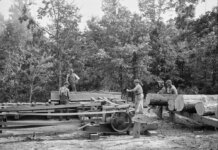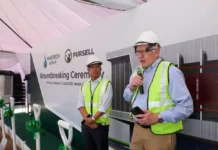
Ask folks about Muscle Shoals, one of the four places that make up north Alabama’s Quad Cities, and the first thing that will probably come to mind is music. Home to the famed FAME recording studio, the area is known for its vibrant music history, as well as its perch on the banks of the Tennessee River.
But one other thing the Shoals city is recognized for, worldwide in scope but little-known even to those who live in the area, is the International Fertilizer Development Center. The IFDC oversees fertilizer and soil research around the globe, with offices in the U.S. and 25 countries. And it’s all based in Muscle Shoals, population less than 20,000.
“People are surprised that it’s here,” says Henk van Duijn, president and CEO of IFDC. “But there’s a long history of fertilizer research here.”
LONG HISTORY OF RESEARCH
IFDC turned 50 last year, but fertilizer research goes back about a century in the Shoals, when the U.S. Department of Defense came to the area to develop nitrogen for bombs.
“You need electricity to make nitrogen, and that’s why we’re near the Tennessee River and Wilson Dam in Florence,” van Duijn says.
By the early 1930s, the thought was that the knowledge gained about developing nitrogen could be used for agriculture, and in 1939, the National Fertilizer Development Center was created under the Tennessee Valley Authority. The impetus? Using that nitrogen to develop fertilizer for U.S. agriculture. “As of today, 60% to 70% of all of the innovations applicable in fertilizer globally are still coming from this area,” according to van Duijn.
That research went international in 1974, when the International Fertilizer Development Center was born.
“Our mandate at the time, because of the National Fertilizer Development Center, was to focus on everywhere other than the U.S.,” van Duijn says. “The NFDC closed in the 1990s, and the IFDC, as of the last two or three years, has also been focusing on the U.S., taking up the legacy of the NFDC.”

SMALL STAFF, BIG IMPACT
IFDC, which became a public international organization in 1977, has 700 employees globally. About 70 of them are in the U.S., including 10 in the IFDC’s office in Washington, D.C., and 60 at the Muscle Shoals headquarters.
“The core of our research and innovation is here in Muscle Shoals,” says Upendra Singh, IFDC’s vice president for research. “Number-wise it is 60 people, but in terms of continuity and long-term investment, the Muscle Shoals office probably has a longer-term impact on our global mission. The impact of our small staff is quite a lot in terms of global impact.”
And what exactly are they doing? Van Duijn says the work is two-fold.
“One part of our work is working with the commercial industry to develop new fertilizer products,” he says. “The second part … is to help farmers around the world use fertilizer in a better way and improve agriculture productivity.”
IFDC, which is not affiliated with TVA but leases its Muscle Shoals facilities from them, receives some private-sector funding, but recent funding cuts to USAID could hit IFDC hard. Real hard.
The funding cut at USAID “has a major impact because USAID support accounts for 30% of the budget and 50% of indirect cost (overhead),” Singh writes in an email, adding that the total impact would be $58.5 million, with $53.5 million of that affecting the Muscle Shoals headquarters.
BIG PLANS FOR FUTURE

Van Duijn and Singh have big plans for IFDC, not the least of which is developing a fertilizer innovation center of excellence. IFDC is already working with startups and universities, but the goal is to expand that model.
“These days, there’s much more demand for innovation within the fertilizer industry,” van Duijn says. “If you look at where we are, fertilizer is a $300 billion business globally. But it’s still building on the same technologies and innovations that were created in the early 1900s.”
The fertilizer innovation center would be “an ecosystem of incubators, startups, universities and ourselves in one location or several locations to really accelerate innovations,” van Duijn says. “Right now, we do research with startups on an individual basis. There is a lot of innovation power in the sector, mostly led by startups. It would be helpful if they started coming together and grow a bigger research capacity than what they’re able to deliver by themselves.”
Though the ultimate goal is to have permanent facilities at one or more locations to house the center for excellence, IFDC already has launched a global fertilizer innovation center network, according to van Duijn.
“Brazil, India and other countries are requesting us to work with them on fertilizer innovation,” he says. “There is a global need to bring innovation and research together to develop innovations in fertilizer.”
RAISING ITS PROFILE

IFDC is working to delineate its work from others in similar areas — other research institutions and universities doing agriculture-based research — and doesn’t see them as competitors.
“We see a clear delineation in roles,” he says. “We will not do anything on plant nutrition, agriculture productivity, new varieties, pest resistance. … We will focus on how the plant grows and how we can assure nutrients are available. That’s our domain.”
In the end, more innovation is going to come out of collaboration, believe the folks at IFDC.
“We do need new technologies, but we also need people thinking together,” Singh says. “We are a neutral organization. We can bring universities and others together to address these questions that need to be addressed for mankind. We should work together on these questions to really make a change.”
Van Duijn says one of those major questions is how to make soil more sustainable.
“In the end, we work with natural resources, and they are limited,” he says. “We add nutrients to the soil, but we take a lot of nutrients away, and that has to change. … Over the last 60 years, we invested heavily in developing new seed variety, to assure they’re pest-resistant and drought-resistant, and that was a big driver, the same with pesticides. What we didn’t invest in was how to restore soil dynamics so that fertilizers, when they’re added to the soil, are used in the most optimal way by the plant.”

And with the fertilizer development center and recent events, including open houses, surrounding its 50th year, IFDC’s profile is starting to rise.
“We are building on a hundred-year legacy, and for us that connection to Alabama is key,” says van Duijn. “Our network is here, our investment is here, and TVA is a big energy partner in the American ecospace.”
It’s something more Alabamians — and others around the world — need to be aware of, the CEO and president says.
“Alabama is sitting on something that’s globally unique, and nobody knows about it,” says van Duijn. “It’s 100 years of American agriculture history — a gem that is undiscovered.”
Alec Harvey is executive editor of Business Alabama, working from the Birmingham office.
This article appears in the May 2025 issue of Business Alabama.



